Proper Planting with Patrick
View this post on Instagram
View this post on Instagram
If you’re looking to add some green charm to your New England garden, Arborvitae and Western Red Cedar is a great choice! These evergreen trees and shrubs not only add year-round beauty but also privacy and character to your landscape. In this guide, we’ll explore everything you need to know about caring for these popular plants in New England.
Before you dive into planting Arborvitae or Western Red Cedar, it’s essential to choose the right variety that suits your landscape and environmental conditions. Consider factors like light requirements, mature size, foliage color, and growth rate.

Western Red Cedars at Mahoney’s in Winchester
Follow these guidelines for successful Arborvitae and Western Red Cedar transplantation:
Soil Requirements: Ensure your soil drains well. Amend heavy clay soils with organic matter and gypsum. These plants have broad root systems, so dig a hole at least twice as wide as the root ball to encourage root spread.
Care in the First Two Years: Pay special attention during the first two years after planting. Adequate watering, especially during dry spells, is critical.
Fertilizing: Apply all-purpose slow-release fertilizer in early spring before new growth fully emerges. Fall fertilizing at half the spring amount helps establish healthy root systems.
Pruning: Arborvitae typically don’t require much pruning, but if needed, shear the outermost growth in late spring to shape or manage size. Start early to avoid overgrowth.
For a handy, printable version of this information, check out our Arborvitae and Western Red Cedar care guide!
Printable Care Guide
Heat Stress: Hot, dry weather can induce heat stress and invite spider mite infestations. Ensure regular, deep watering to boost plant vigor and natural defenses.
Bagworm Moths: While not typically destructive, bagworms can cause unsightly defoliation. Hand removal is often sufficient or use organic pesticides like Neem Oil for larger infestations.
Deer Damage: In areas with high deer populations, consider planting Western Red Cedar (Thuja plicata) as it’s less favored by deer compared to Eastern Arborvitae (Thuja occidentalis).
Don’t panic if your Arborvitae turns brown inside during fall; it’s a natural process called seasonal needle drop. Fresh growth in spring will fill in any gaps left by this process.
Keep your Arborvitae and other evergreens well-hydrated in autumn, as it prepares them for the harsh winter conditions common in New England. Water regularly from September through early December to reduce winter stress. For more information on establishment watering for newly planted trees, see our printable Planting Guide.
Here are some popular Arborvitae cultivars carried at Mahoney’s Garden Centers:
Please note that actual plant characteristics may vary depending on soil, sunlight, and water conditions.
Incorporating Arborvitae and Western Red Cedar into your New England or Boston garden can be a delightful addition, providing year-round beauty, privacy, and resilience. These versatile plants, with proper care and maintenance, will thrive in your outdoor space, enhancing its charm for years to come.
Shop a wide selection of Arborvitae and Wester Red Cedar in-store and select varieties online.
Shop Online
July 4th is upon us – the day we celebrate the birth of our nation. Looking back to 1776, trees and the lumber they provided were a critical natural resource, providing the raw material for shipbuilding. While modes of transportation have changed in the 247 years since our independence was declared, trees are still an important symbol of our nation’s strength and identity.
Their ongoing importance was recognized in 2004 when Congress passed legislation designating the Oak as America’s National Tree. The Oak was selected by a vote hosted by the National Arbor Day Foundation, in which Americans of all ages and from all walks of life chose the Oak over 20 other varieties of tree to be our national symbol.
There are more than 90 species of Quercus, the Latin name for Oak, growing in the United States. They have been an important part of our national history and folklore. Did you know that the USS Constitution took its nickname “Old Ironsides” from the strength of its oak hull?
Today, oaks are recognized as playing a crucial role in the ecosystems of our world:
So many reasons to celebrate our national tree on our nation’s birthday!
In tropical climates any hibiscus can go right in the ground and turn into huge trees and shrubs that bloom more or less year-round. Here in New England, we enjoy a more modest tropical display, in both size and season. But even here in Massachusetts, the world of hibiscus is fascinating and worth a deeper look.
In the Bay State it’s important to know what kind of Hibiscus you’re getting and how you can expect it to behave. For our purposes, there are three types to consider: Tropical Hibiscus, Rose of Sharon, and Perennial Hibiscus.
Tropical Hibiscus (Hibiscus rosa-sinensis) can be found in our greenhouse, or among the annuals during the warm months. This type of Hibiscus is hardy in USDA growing zones 10 and 11 (think Central Florida and further south from there). Here in zone 6, we can enjoy tropical Hibiscus outdoors through late spring and summer but they will not survive our winters and should be considered an annual plant. If you have a lot of sun in your home you could also consider it a houseplant and you can enjoy its gorgeous blossoms year-round!
There are thousands of cultivars of tropical hibiscus available today. A few notables include Red Hot Tropical Hibiscus, Chinese Lantern, Mahoe, and Fiji Island in addition to the traditional red varieties. In the Middle East and Africa, a popular drink called karkade is made from the dried flowers of red hibiscus. It can be drunk cold or hot and is said to have numerous health benefits and it is used to soothe ailments such as colds, high blood pressure, intestinal, circulatory, and skin disorders and more.
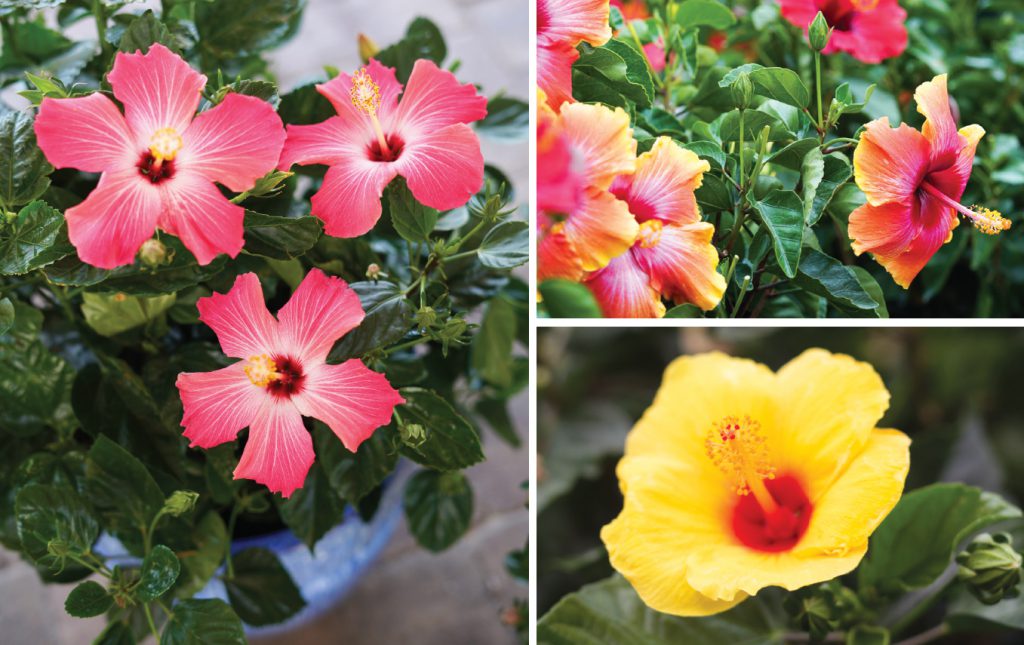
Tropical Hibiscus
Rose of Sharon (Hibiscus syriacus) is a deciduous shrub hardy in USDA growing zones 5 through 9, good news, zone 6, we’re in! It will lose its leaves in the winter and put out new growth in spring. Very little pruning is required as these shrubs maintain an upright growth pattern.
These hardy shrubs bloom late into the season when little else is in bloom. They are low-maintenance and easy to grow and come in many forms including dwarf, columnar, upright, and tree form, and flowers can be single, double, or semi-double. You’ll find them in exciting and unexpected colors including reds, pinks, purples that are almost blue and even multicolor blooms. They are heat, drought, and salt tolerant (perfect for the Cape), deer resistant and a favorite of butterflies and hummingbirds!
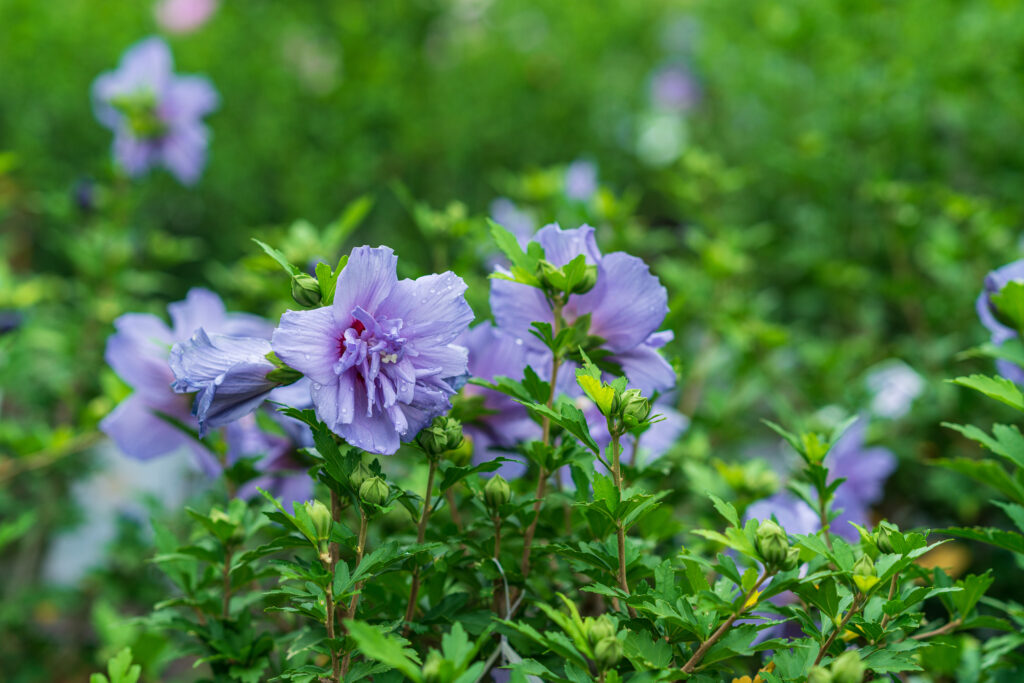
Perennial Hibiscus (Hibiscus moscheutos) is a fun one. Hardy in USDA zones 4 through 9 this hibiscus will lose all its leaves in the winter and resemble dead sticks come spring. Leave those sticks there through the winter months then, in the spring cut them all the way back, almost to the ground. Late May, early June you’ll start to see new growth come up from the ground and boy does it come up fast! Enjoy gorgeous blooms the size of your face all summer long!
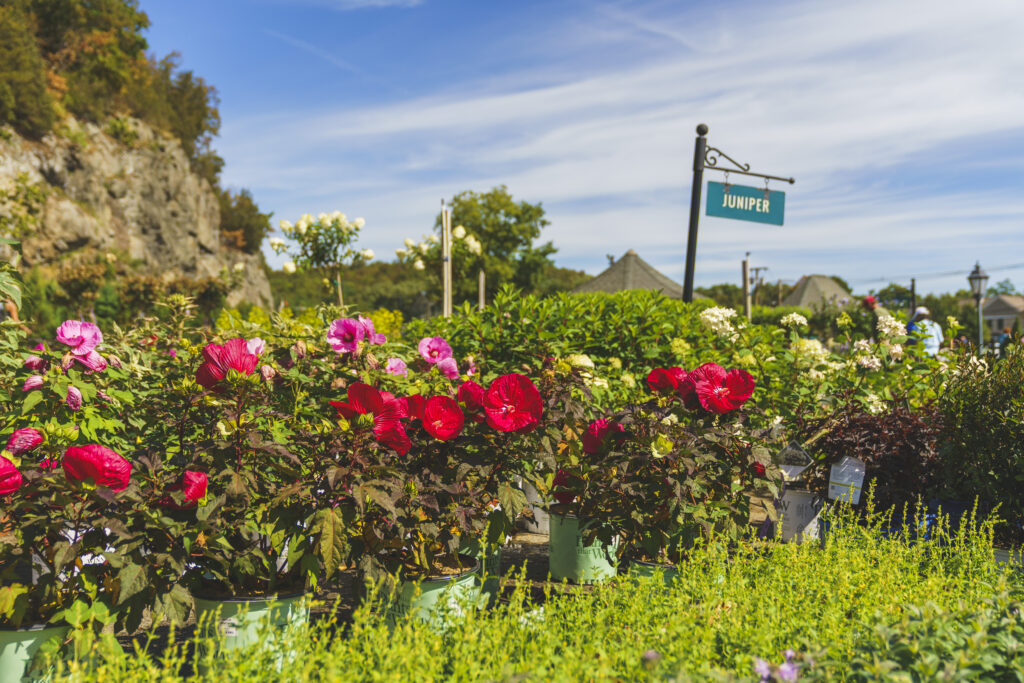
Perennial Hibiscus
The spring flowers of Azaleas, Rhododendrons, Forsythia, Lilac and Viburnum are always so welcome after a long winter season. To ensure those beautiful blooms for next year’s spring, it is important to know when and how to prune them.
Spring flowering shrubs bloom on “old wood,” meaning growth that took place in the previous year. Another way to think of it is, the flowers you enjoyed this year were formed in the summer of last year. The window of time to do any pruning is after springtime flowering but before next year’s flower buds form. If you need to set a reminder in your calendar, a rule of thumb is to prune no later than July 4th. If you prune in late summer or fall, you will be removing next year’s flowers. It is generally recommended not to remove more than one-third of a shrub’s mass in one year. The shrub needs the remaining two-thirds leaf mass to maintain its vigor and health.
Pruning will control size, improve shape and encourage healthy branching. To shorten a branch, follow the branch down from the tip to the leaf you want to keep. Choose an outward facing leaf as this will direct the plant to make any future growth towards the outside, rather than encouraging further congestion in the inside of the plant. Make the cut one quarter inch above the topmost leaf you wish to keep.
To reduce the height of shrubs such as Forsythia, remove the tallest canes by cutting them out at ground level. Thin out any canes crowding the center to allow light and air to reach the interior. Remove canes growing in an unwanted or unruly direction.
Use this method to maintain your spring bloomers as needed. Read on for particular pruning methods that may become necessary if your lilacs or forsythia become truly overgrown.
While the pruning principles above apply to a reasonably sized lilac, we often find ourselves with a shrub that is far too large. After all, don’t we want the flowers at a level where we can bury our faces into that heavenly fragrance?
The technique of “rejuvenation pruning” will bring an unruly lilac back to a manageable size. The preferred time for rejuvenation pruning is just before bud break in early spring (late March, early April) but it can be done any time in the spring or summer. In the first year, cut one-third of the oldest, most unproductive stems down to the ground. The next year, take out another third of the old stems, again at ground level. In the third year, remove the remainder of the old stems. New productive stems will quickly replace the old wood. While it takes three years to complete, the shrub stays attractive throughout the rejuvenation period. And after three years you have a brand new shrub. Maintenance pruning in the following years will keep flowers at a height where they can be best appreciated.
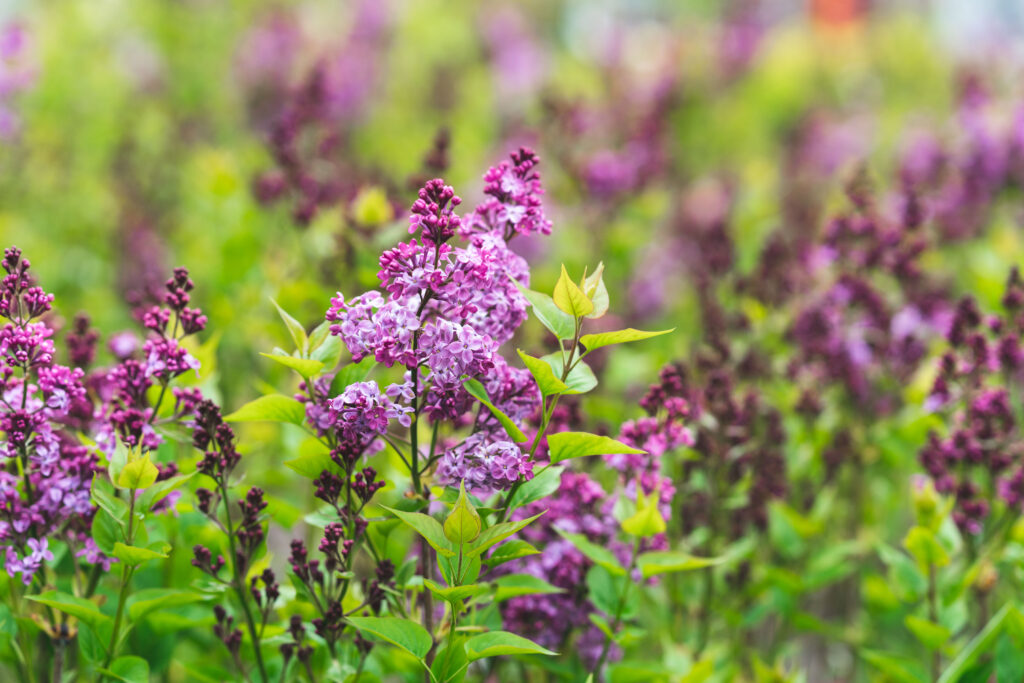
Forsythia, which is a vigorous shrub, can be cut completely to the ground if it is wildly overgrown. New shoots will form and grow into stems. In the second year, select the strongest of the new canes and prune out the weaker ones. In the third season, begin an annual maintenance pruning regimen.

Can you think of a more beloved plant in New England than the Hydrangea? Its flowers have many forms, ranging from beautiful rounded mopheads in shades from light blue to rich, almost purple blue; to showy panicles in shades of pink and white; to delicate lacecap flowers in tones of pink and blue. New varieties are expanding the range of flower color into the red spectrum. In terms of size, there are varieties ranging from 2ft to 8ft in height. Some varieties can even be grown in containers. And the climbing hydrangea is as beautiful as it is unusual. Some varieties are also available in tree form. This means there is a hydrangea for every location!
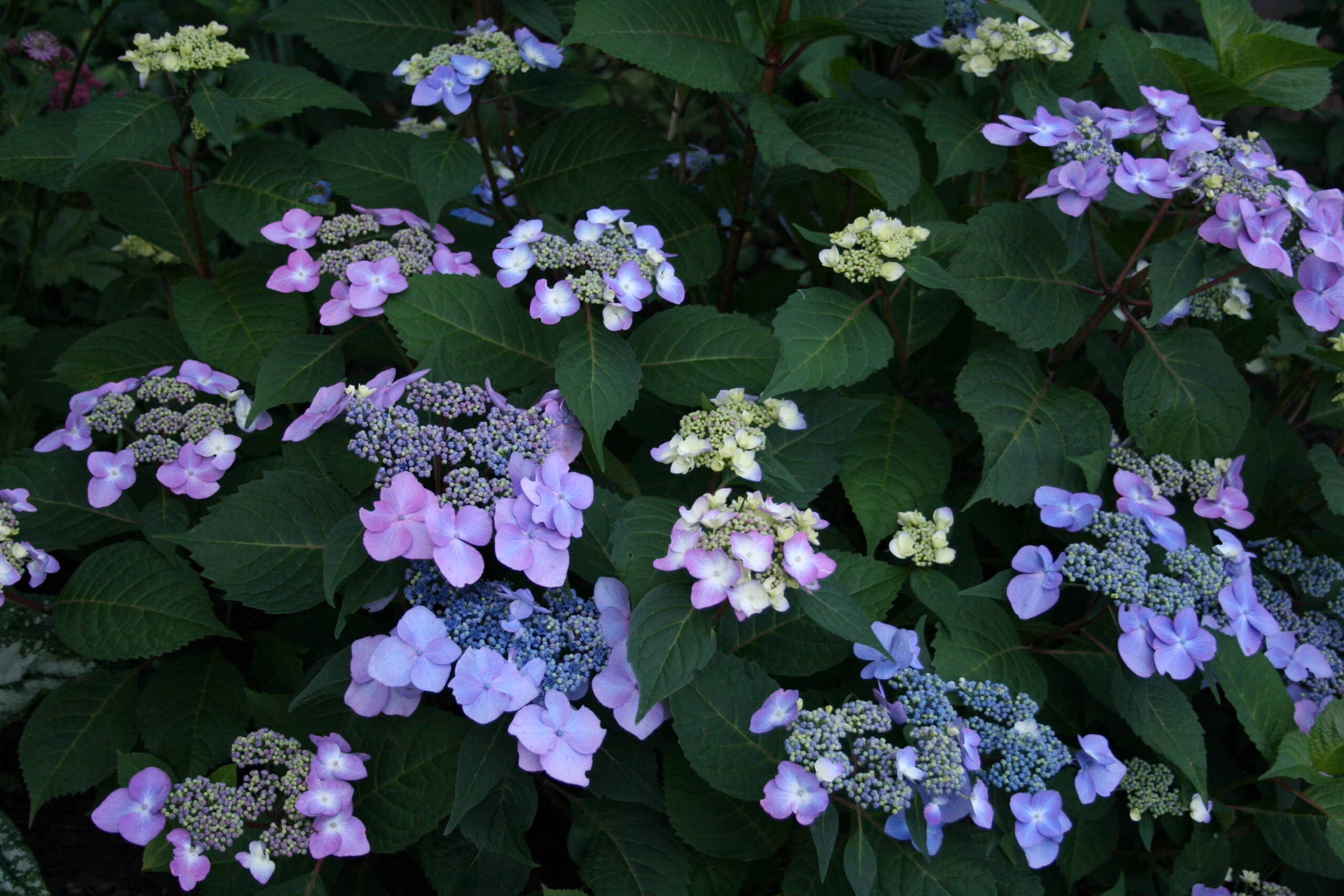
Hydrangea macrophylla “Twist n’ Shout”
There are 6 species of Hydrangea commonly grown in our area:
For more information about each of the 6 species of Hydrangeas, including information about when to prune, see our Hydrangea Plant Care Guide.
Hydrangeas come into bloom just as the first flush of roses is fading. Beginning in late June and continuing into the fall, they offer a strong presence and a long season of interest in the garden. The flowers subtly change color as they mature, often remaining on the plant into and through the winter, fading to a lovely tan color. The stems of the plants remain upright through the winter, adding structure and form to the winter landscape.
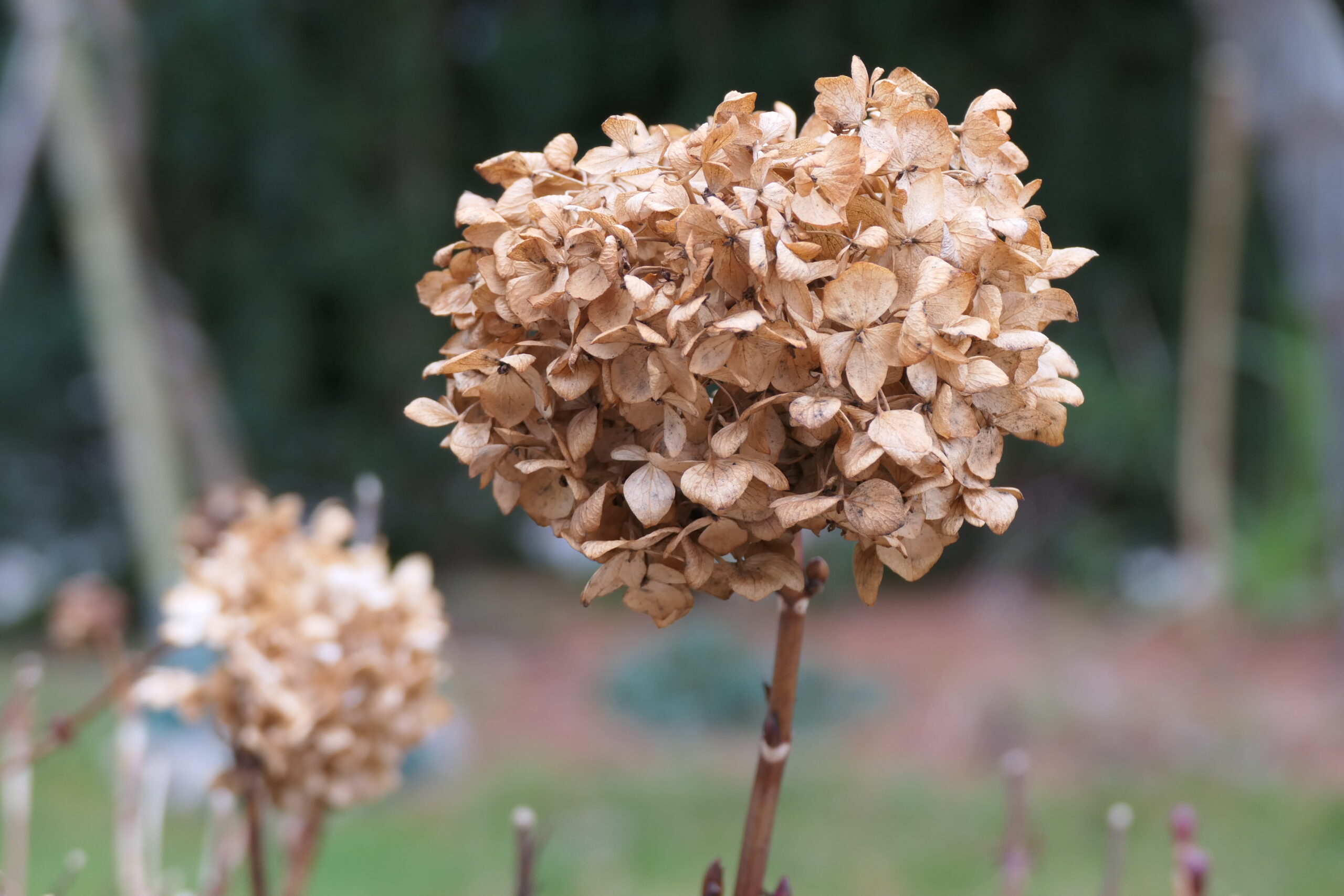
Hydrangea flowers and interest to the landscape even in winter!
We love Hydrangeas for the wonderful show of flowers they provide. However, in some years, winter conditions can affect that show. In harsh winters the dormant flower buds may be damaged, either by extreme cold or by an unusually warm period followed by a sudden return to frigid conditions. Temperatures of minus 10-15 degrees, which we experienced in early February 2023, combined with a lack of insulating snow cover, may mean a diminished show this summer.
Plant breeders are doing wonderful things to improve the performance and increase the varieties of Hydrangeas available to us. They have a bright future. And a long past. Hydrangeas have been found in fossils from 45-60 million years ago!
When in season, select Hydrangeas are available on our online store for pick-up and local delivery!
Shop Hydrangeas Online
View this post on Instagram
Your evergreens are hungry! Spring is a great time to feed with Holly-Tone to help them be their best all season. Watch as Patrick demonstrates how to feed a holly with Holly-Tone. Right now Holly-Tone and Plant-Tone are on special: 18 lb. bags for $19.50 (reg. $24.99) and 50 lb. bags for $39.50 (reg. $49.99). Available at all locations.
“Is this a good time to prune my…?” The question of when to prune is one we often hear. The confusion is understandable since some shrubs are best pruned in spring, others in summer, and still others prefer to be shorn in the fall.
Late winter or very early spring is the best time to prune shrubs that flower on “new wood” — the growth that forms in spring. Late March to mid-April is ideal. These shrubs form their flower buds in the spring and early summer, and bloom in the summer and into the fall.
Here are our favorite new wood bloomers who would love (and reward you handsomely) for a fresh spring haircut right now:
Buddleia davidii
As you may have guessed from the name, these are pollinator favorites that offer lovely fragrant blooms late in the summer. To keep this shrub a manageable size, don’t be shy about pruning it to a height of 12-18 inches. Fortunately its branches are slender and easy to prune with hand-held pruners.
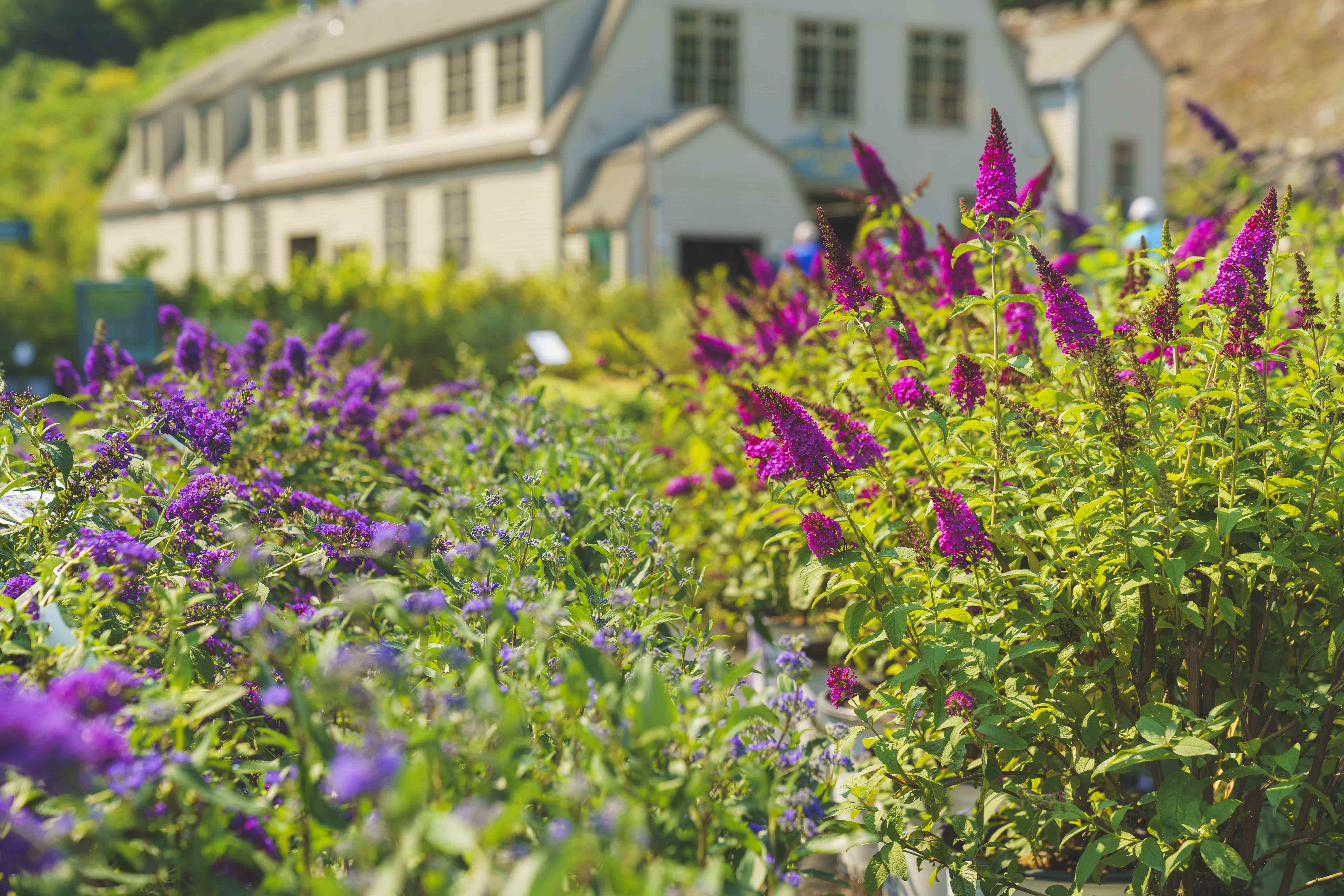
Buddleia
Caryopteris spp.
These late summer bloomers will be covered in delicate looking blue flowers that draw butterflies, bees, beneficial insects, not to mention admiring comments from your neighbors. Like Buddleia, its branches are easy to cut and should be taken back to 12-18 inches. While this early spring pruning seems drastic, the plant will quickly flush new growth.
Hibiscus syriacus
Rose of Sharon is valued for its late summer blooms that cover the shrub from top to bottom. However, if left unpruned, it will develop sturdy, but bare, upward growing branches and the flowers will be above eye level. An early spring pruning each year will keep the flowers where you can most enjoy them.
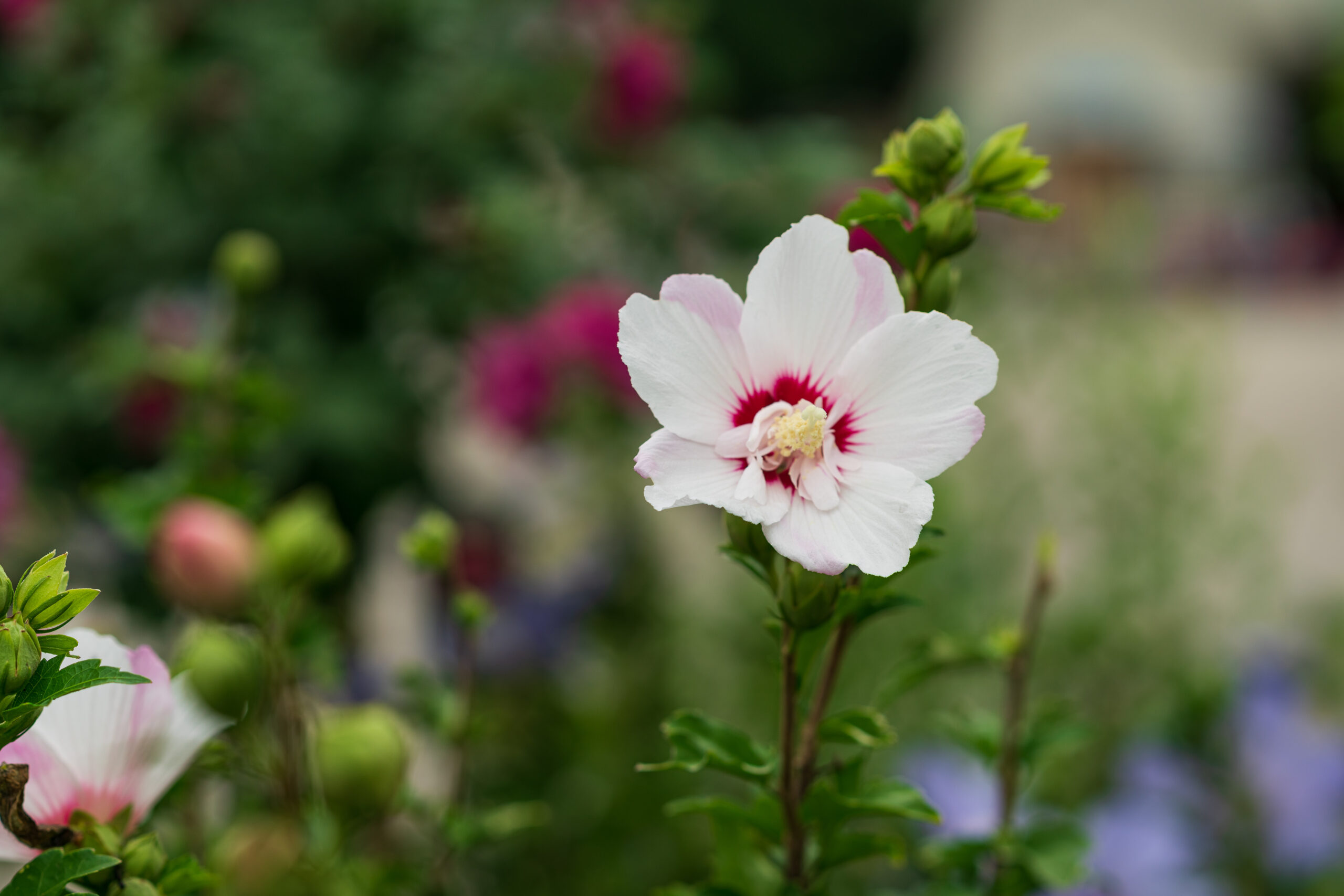
Hibiscus
Hydrangea paniculata
These showstoppers have cone-shaped flowers that initially appear in white and cream tones before deepening to shades of pink and red. Once they reach maturity, this type of Hydrangea can be pruned to almost any height.
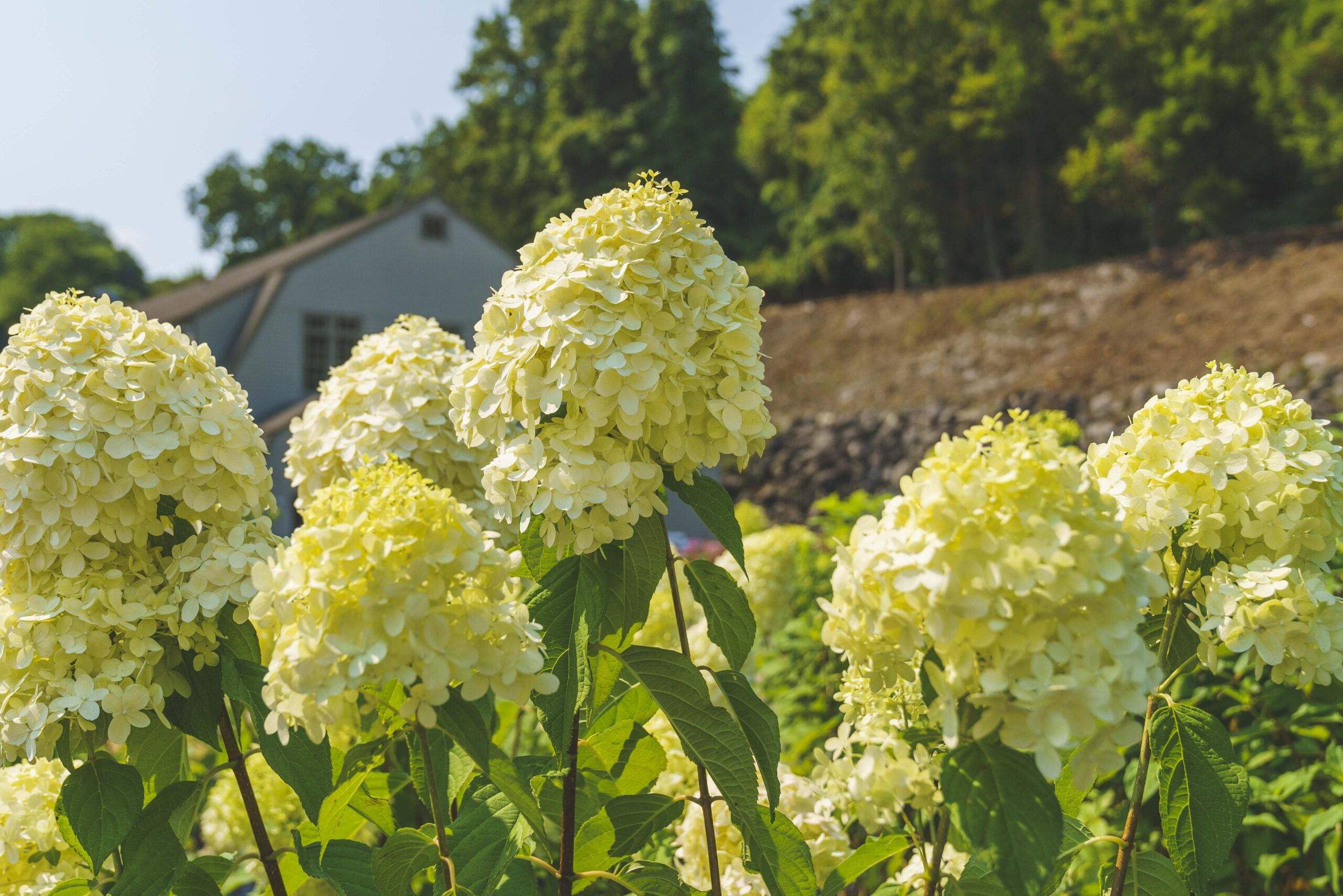
Panicle Hydrangea
Hypericum perforatum
St. John’s Wart has been known for its medicinal benefits for hundreds of years. In our gardens, we love its yellow buttercup type flowers and red berries that we often use for holiday decorating. Pruning to a height of 12-18 inches and watch it rebound to a height of 3 feet!
Ilex verticillata
Winterberry is prized for its heavy showing of red berries that remain on the shrub well into winter before they are sweet enough to tempt the birds. This shrub is easily pruned to a size of your choosing.
Potentilla spp.
This collectible shrub offers a bright spot in the landscape with flowers in tones of yellow, pink, red or white. Its delicate leaves and gently spreading structure add to its appeal. Prune gently to keep it neat and tidy.
Rosa spp.
As our very own rosarian Jeannette likes to say, “when the forsythia blooms in New England, it’s time to prune your roses. Watch as Jeannette takes you through her tried and true techniques for early spring rose pruning.
Spiraea spp.
With its brightly colored flowers, Golden elf is a steady performer and so easy to love for its easy care and longevity. Like Potentilla, it happily accepts pruning in early spring.
You might be saying what about Rhododendrons and Azaleas? And our beloved Lilac and Forsythia? Don’t worry about those just yet, they are best left alone in early spring. Fear not, we’ll be sharing some information about pruning these shrubs when the time is right (Hint: after they flower!)
For pruning techniques and best practices read our Spring Pruning Basics for New England blog!
Shrubs add beauty and structure to our gardens. During the first few years after planting, a shrub requires little to no pruning. As it matures, selective pruning can increase bloom, improve shape and or reduce size. Whatever your objective, intentional pruning helps produce a natural looking shrub with a graceful form. Below we’ll walk through the basics of spring pruning from tools to technique!
Use clean, sharp hand tools rather than electric shears. Shearing a shrub promotes dense growth at the branch tips. This blocks light and inhibits air circulation inside the shrub, which can eventually lead to the shrub’s decline, either by disease or lack of foliage for photosynthesis. And remember to always disinfect your tools with rubbing alcohol before you begin.
A shrub is not a poodle. Never remove more than one-third of the shrub’s mass in any given year. This preserves enough foliage for the plant to make sufficient food to stay robust and generate new growth quickly.
Choose a pruning method that meets your goals and the plant’s needs.
A “heading cut” is used to shorten a branch. The direction in which the top remaining bud is pointing will determine the direction of new growth. Prune one quarter inch above the bud, making the cut at a slight angle.
A “thinning cut” reduces the density of the shrub by removing branches at their point of origin from the center of the shrub.
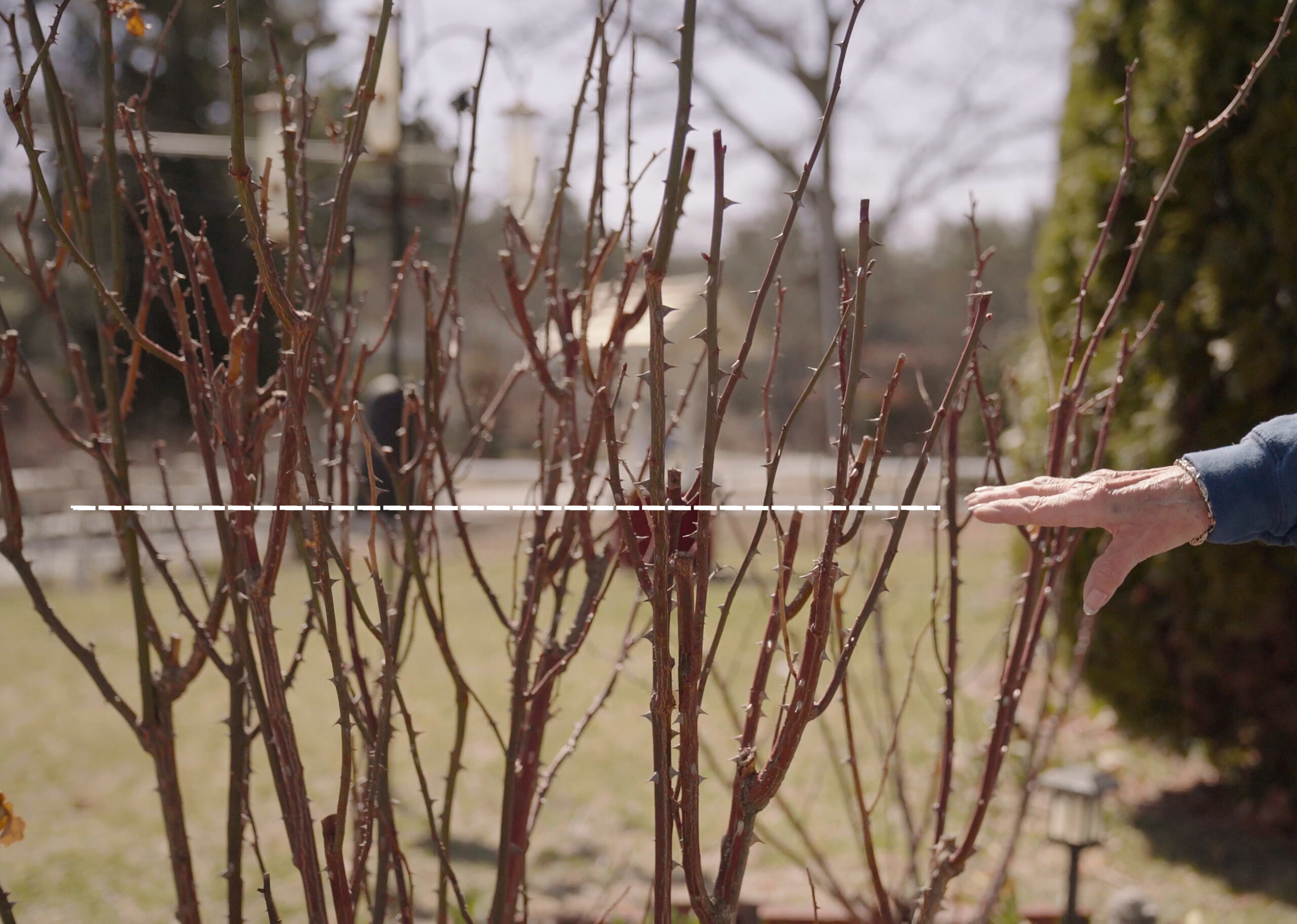
Always remove dead, diseased or broken branches as soon as you notice them.
With few exceptions, you should avoid coating pruning cuts on shrubs or trees with wound dressing or paint. Trees and shrubs have their own mechanisms to heal a wound and need oxygen for proper recovery. In some cases wound dressings inhibit the availability of oxygen which is needed for proper recovery.
Different shrubs should be pruned at different times of the year depending on their individual biological make-up and bloom season. Read our blog on Nine Shrubs to Prune in April for some of the common favorites who would benefit from an early trim!
When the forsythia blooms, it’s time to prune your roses! Our very own rose expert, Jeanette, loves roses and loves to show what she knows about them. Join us as Jeanette takes us step by step through her guide to pruning roses in early Spring. Note: the roses featured are Hybrid Tea roses that will benefit from a prophylactic dose of fungicide or neem oil after pruning. Other varieties are such as Knock Out Roses or David Austin are less susceptible to such issues and you can skip that step with those!